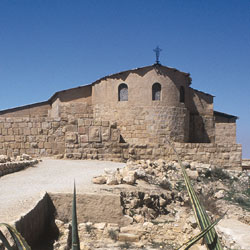|
Mount NeboMount Nebo is where prophet Moses was given a view of the promised land that God was giving to the Jews. "And Moses went up from the plains of Moab to Mount Nebo, the top of Pisgah, which is opposite Jericho." (Deuteronomy 34:1). Moses was buried on this mountain by God himself, and his final resting place is unknown.
On March 19, 2000, Pope John Paul II visited the site during his pilgrimage to the Holy Land. During his visit he planted an olive tree beside the Byzantine chapel as a symbol of peace.
|
 On the highest point of the mountain, Syagha, the remains of a church and monastery were discovered in 1933. The church was first constructed in the second half of the 4th century to commemorate the place of Moses' death. It was enlarged in the late fifth century A.D. and rebuilt in 597A.D. Six tombs have been found hollowed from the natural rock beneath the mosaic-covered floor of the church. In the modern chapel presbytery, built to protect the site and provide worship space, you can see remnants of mosaic floors from different periods. The earliest of these is a panel with a braided cross presently placed on the east end of the south wall.
On the highest point of the mountain, Syagha, the remains of a church and monastery were discovered in 1933. The church was first constructed in the second half of the 4th century to commemorate the place of Moses' death. It was enlarged in the late fifth century A.D. and rebuilt in 597A.D. Six tombs have been found hollowed from the natural rock beneath the mosaic-covered floor of the church. In the modern chapel presbytery, built to protect the site and provide worship space, you can see remnants of mosaic floors from different periods. The earliest of these is a panel with a braided cross presently placed on the east end of the south wall.